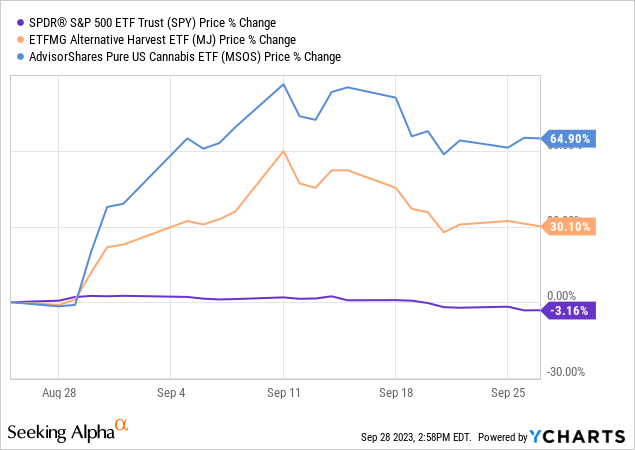Investment Thesis
During the Reagan days, the US went hard on its war against drugs. Cannabis got the short end of the stick and found itself lumped into the Schedule I drug category, a class reserved for substances deemed to have the highest potential for abuse and addiction. Yep, it is right up there with heavy hitters like Heroin and LSD and, officially, two notches riskier than Fentanyl, which is causing all sorts of trouble today. Fast-forward to now, and there’s a buzz in the air that things might be changing, and the stock market’s already riding the high.
Enter the Biden administration. They’ve nudged the DEA, via the US Department of Health Services, to think about shifting Cannabis from the “big bad” Schedule I down to a more chill Schedule III. This isn’t just a bureaucratic shuffle. It is a game changer for the green business.
Check out the market’s reaction to this! While the broader S&P 500 (SP500) index took a 3.6% hit over the last month, our cannabis buddies at ETFMG Alternative Harvest ETF (MJ) and Pure US Cannabis ETF (MSOS) saw spikes of 65% and 30%. That’s not just a flash in the pan. This rally is only getting started. Here is why:

For starters, even with this uptick, cannabis stocks are coming up from some seriously low places. Most are trading below their book value. Out of the 50 or so publicly traded cannabis companies, only 17 have a Price-to-Book greater than 1x. To me, it sounds like there’s more room for growth.
Also, history’s got our back on this one. The DEA usually vibes with what the HHS suggests. A Congressional Research report from last week also chimes in with this sentiment. Check out the highlighted text below:
Congressional Research Services Report. September 13, 2023
So, if this reclassification goes down, what’s in store for the cannabis world?
- Tax Breaks: That pesky 280e rule that’s been bugging cannabis companies? It might get the boot. That rule’s been a real pain, stopping tax deductions on ordinary expenses like R&D, accounting, legal and management expenses. Cannabis companies are taxed on gross instead of net earnings. Imagine the instant economic boost with this tax relief.
- Banks on Board: Cannabis companies, for the longest time, have been virtually outcasted by banks due to the federal-state dissonance on cannabis. With reclassification, this industry can finally gain legitimate access to vital banking services.
- Logistics: We’re talking about the interstate cannabis trade. That means more efficient moving of goods for the industry, likely dropping costs along the way.
With most folks being pretty cool with cannabis these days, it’s hard to see Congress throwing a spanner in the works. The bottom line is we might be on the cusp of some exciting times for the cannabis sector.
The Game Plan
President Biden’s moves are creating waves in the cannabis sector, giving every ship the chance to sail high. But, instead of hopping on any boat, be savvy with your investment choices. Don’t sail blind, just in case the wind becomes unpredictable [again]. The true champions are those with proven profitability. We’re talking about companies that have laughed in the face of industry challenges and flaunted profitability records. Remember, it’s not just about riding the wave, it’s about ensuring a smooth sail.
This narrows the scope quite a bit. Profitable cannabis companies are a very elite group. Out of the crowd of 50 publicly traded cannabis businesses, only four are turning profits based on GAAP. And guess what? I’ve got the VIP list here:
- Vext Science (OTCQX:VEXTF)
- MariMed (OTCQX:MRMD)
- Green Thumb (OTCQX:GTBIF)
- Leafly (LFLY)
I’ll save the scoop on Leafly for another time and focus on MRMD, VEXTF, and GTBIF.
#1 MariMed
Let’s pull back the curtain on MRMD and really see what makes them tick. We’re diving deep, but since this is a list piece, I’ll keep it breezy.
Consulting Roots: A Step Ahead from Day One
Before they took the plunge into cannabis cultivation and selling, MRMD started out as consultants. This gave them an insider’s look into the industry’s highs and lows. That means when they transitioned from giving advice to joining the game, they weren’t some newbies. They had a playbook filled with insights, and that’s gold in a nascent market like cannabis, where the most experienced veteran would have at most seven years of experience.
Adapting and Conquering: The MSO Way
Multi-State Operators show a high degree of adaptability. Each state offers its unique regulatory maze and potential customers. MRMD is one of the two MSOs nailing this challenge by showcasing profitability. For those curious, below is a list of MSOs in the cannabis sector.
- Cresco Labs (OTCQX:CRLBF)
- The Cannabis Co (OTCQX:CBSTF)
- Trulieve Cannabis (OTCQX:TCNNF)
- Curaleaf (OTCPK:CURLF)
- Green Thumb (OTCQX:GTBIF)
- MedMen Enterprises (OTCQB:MMNFF)
- Acreage Holdings (OTCQX:ACRHF)
- Ayr Wellness (OTCQX:AYRWF)
- Verano Holdings (OTCQX:VRNOF)
- Jushi Holdings (OTCQX:JUSHF)
MRMD By the Numbers: A Snapshot
- Net Income (2022): Clocking in at a solid $13.5 million. Not too shabby, especially when compared to the hundreds of millions of losses from peers.
- Market Cap: Sitting at $164 million. A mid-sized stature. Not as rigid as mega-caps and not as risky as microcaps.
- EV/EBITDA: Coming at 8.5x. At first, this might give an impression of a reasonably valued enterprise. But, with the industry’s growth pace, I’d give this another look.
- Quant Rating: It’s a buy. This is Seeking Alpha’s way to giving a thumbs-up.
#2 Vext Science
In a wild, fast-paced world of cannabis, where everyone’s trying to outdo each other with flashy R&D and spending sprees, VEXTF is like that chill dude who knows exactly what he’s doing. They’re not trying to be everywhere. They’ve set up camp in Arizona and are expanding their territory slowly and smartly. They’re not in a mad dash to be in every state. Instead, they’re kind of taking the ‘quality over quantity’ approach. When they do decide to dip their toes into new territories, they usually partner up, easing into joint ventures.
Earlier this year, they decided to boss up and buy out their partner’s share in the Ohio JV. Here’s the kicker: Adult-use cannabis is on the ballot in this state, which now only permits Medical Use. The cannabis recreational use market size leaves medical in the rearview.
The main issue with VEXTF is its thin trading volumes. If you plan to trade more than a few hundred dollars at a time, you might want to check out Green Thumb instead.
#3 Green Thumb
Among the big boys of MSOs (those with Enterprise Value of +$1 billion), GTBIF is kind of the rock star. They’re the only name in the group turning a real profit, which is a big deal in this young, wild west of an industry.
Green Thumb
They’ve got a presence from coast to coast, covering fifteen unique markets. What sets it apart from other profitable cannabis companies is its dynamic product portfolio. They don’t just sell flowers. They’re rolling out everything, from vapes to pre-rolls and edibles. Remember the hype about those Show Dog premium pre-rolls they dropped in Illinois back in April? They’re taking that show on the road, hitting spots like Maryland, Nevada, and Massachusetts next year.
Summary
The cannabis sector is shifting and growing fast. With all the political developments hinting at the possible reclassification and the markets showcasing some real oomph, it’s no wonder there’s a lot of excitement in the air. But, let’s not get ahead of ourselves and jump in without looking. My Approach? A solid mix of ‘let’s ride this wave’ and ‘let’s not trip up.’ Given the maze of Washington’s checks and balances, it’s smart to play this with both eyes open. Now, they might not be the talk of the town with swanky outlets or the trendiest strains, but MRMD, VEXTF, and GTBIF are onto something. With years of profits and deep industry knowledge, smart moves, and a killer product line-up, they’re poised to ride the industry’s growth. The bottom line is the cannabis game looks bright, but navigating it takes a cool head, some caution, and perhaps a dash of hope.
Editor’s Note: This article discusses one or more securities that do not trade on a major U.S. exchange. Please be aware of the risks associated with these stocks.
Read the full article here












